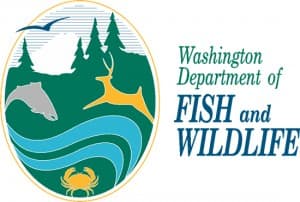Now Playing in Washington: The Invasion of the Baby Snatchers
OutdoorHub 06.19.12

It’s fawn-napping time again.
And we don’t mean baby deer taking naps.
No, unfortunately it’s that time of year when too often too many people “kidnap” fawns — and other wildlife babies — found outdoors.
They often think they’re saving an abandoned baby, says Washington Department of Fish and Wildlife (WDFW) biologist Patricia Thompson.
“But most of the time they’re actually kidnapping a baby out from under the watchful eye of a nearby but unseen mother deer,” Thompson said. “It’s the annual re-run of “The invasion of the baby snatchers.”
Thompson, who coordinates Washington’s licensed wildlife rehabilitator program, takes calls nearly every day at this time of year from well-intentioned but uninformed people.
Sometimes she can talk people into leaving the fawn where it is or putting the fawn back where they found it so the doe can reunite with her baby again. But too often she has to enlist the help of a licensed rehabilitator trained in wild animal care.
“An uninjured fawn really doesn’t need human care,” she said. “It needs its mother. In the rare case of a truly orphaned fawn, it needs a special diet and treatment, as well as no human contact to eventually be rehabilitated back to the wild.”
Thompson says it’s frustrating because WDFW has been promoting “leave wild babies in the wild” forever, and information has been available for years on WDFW’s website (http://wdfw.wa.gov/conservation/health/rehabilitation/when_not_to_rescue.html ).
“Sometimes I think people just can’t help themselves,” she said. “When a wild baby seems helpless or abandoned, you want to help.”
But that help can ultimately be a death sentence for young wild animals, which are often intentionally left alone for hours while their parents gather food.
Doe deer leave their fawns alone to avoid drawing predators with their own body scent. Young birds commonly leave the nest before they are fully-feathered and are fed on the ground by their parents for a day or two until they are able to fly. It is common to see very young American robins, spots and all, on the ground waiting to be fed by mom or dad.
More often than not, just leaving a young animal alone affords it the best chance for survival.
Leaving these babies alone means you need to confine cats, dogs and other pets that can cause lethal injury. One of the most common causes of injuries to wildlife, is attacks by cats. Any animal attacked by a cat needs a wildlife rehabilitator’s care, even if it does not look injured. Cat bites often cause serious infection.
One of the few situations in which almost anyone can help wild babies is when very young, un-feathered birds have fallen out of the nest and are on the ground.
If you can find the nest and safely reach it, simply pick up the nestling with a gloved hand and put it back in the nest. Contrary to popular belief, the parent birds will not reject their young because it’s been handled by humans.
Thompson recently reported a situation where a fawn was hung up in a fence, probably while trying to follow its mother. It was freed by a neighbor who watched it run around by itself for a day, but then witnessed it reunite with its mother to nurse.
In another recent incident, a fawn brought in to a licensed wildlife rehabilitator was returned to the pick-up spot within 24 hours. When released by the rehabilitator, the fawn cried out and within minutes a doe appeared, stomping its feet at the human (who quickly exited so the two could reunite.)
Wild animals of any age that show obvious signs of illness or injury such as bleeding, vomiting, panting, shivering, or ruffled feathers or fur, or that are just lethargic and make no effort to escape your approach, may indeed be in need of care. However, call a wildlife rehabilitator first before attempting to pick the animal up.
Most Washington counties have wildlife rehabilitators, listed with phone numbers and addresses for 24-7 access on the WDFW website at http://wdfw.wa.gov/conservation/health/rehabilitation/ .
If you and a wildlife rehabilitator decide it might be best to help the animal, find out from them how to safely contain and transport the animal. Always wear gloves when picking up a wild animal to place it in the container. Until the animal is transported to the rehabilitator, keep it in a warm, quiet, dark place.
Another way to help wildlife, whether or not you find an injured animal in need of care, is to support your local volunteer wildlife rehabilitators. All of these volunteers must establish and maintain a good working relationship with a cooperating veterinarian, and many are veterinarians themselves; none can charge for their services to wildlife, but may accept donations.

